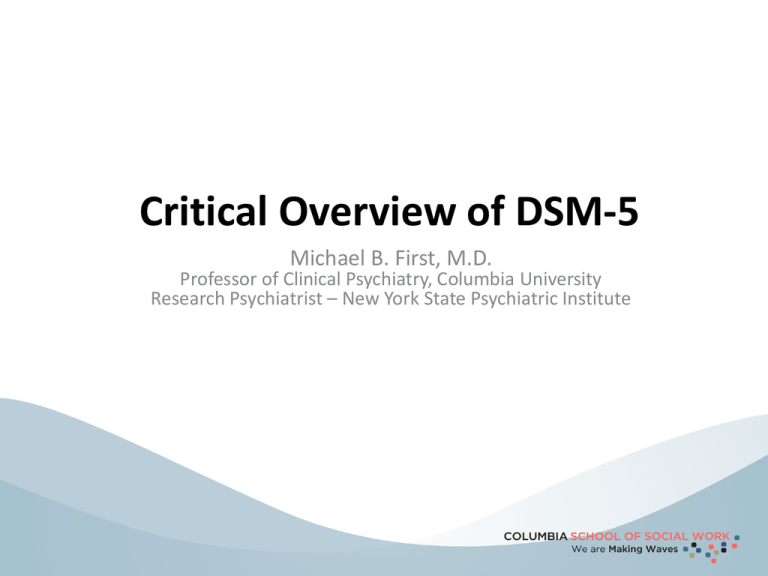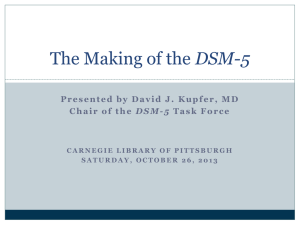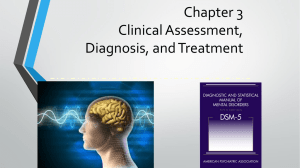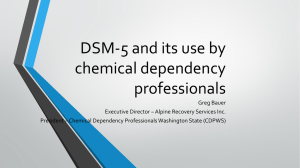Critical Overview of DSM-5 – Michael First, MD
advertisement

Critical Overview of DSM-5 Michael B. First, M.D. Professor of Clinical Psychiatry, Columbia University Research Psychiatrist – New York State Psychiatric Institute Value of Making a DSM Diagnosis • Well defined and reliable terminology facilitates communication among clinicians, administrators, lawyers, patients, and families • Provides convenient short-hand when describing psychiatric presentations • Assigning DSM diagnosis provides direct access to psychiatric literature about treatment, prognosis, etc. • Journal articles, practice guidelines, textbooks) for past 33 years have been geared to DSM definitions of mental disorders • Facilitates assignment of diagnostic code for payment Limitations of Making a DSM diagnosis • Most treatment decisions are geared to symptoms regardless of diagnosis (e.g., psychosis) • Diagnostic heterogeneity limits predictive power of diagnoses • Diagnoses are not informative about etiology or pathophysiology • High rates of NOS limit clinical utility in terms of communication and access to the literature Why a DSM-5 is needed • Longest gap between DSM’s ever • DSM-IV criteria sets reflect research base circa 1993 (20 year gap) • Text reflects research base circa 1999 (14 year gap) • Need to coordinate with ICD-11 (to be published in 2015) • Potential for DSM-5 to update definitions to reflect most recent research findings and to address identified weaknesses Will DSM-5 Be More “Etiological” and/or based on objective measures? • The simple answer: No. • Genetics, neuroimaging, biological markers, etc. will NOT be included in definitions of disorders in DSM-5/ICD-11 – Exception: polysomnography in sleep disorders and hypocretin in Narcolepsy • Problem is lack of diagnostic specificity on an individual patient level – Tests able to identify clear differences between groups but not between individuals because of within group variability (i.e., some non-affected people will have abnormal value on test that is higher than “affected” individuals ) Changes in Diagnostic Groupings (“Metastructure”) • DSM-IV diagnostic classes mostly based on shared symptom presentation (e.g., anxiety disorders). • DSM-5 regrouping of disorders reflects 20 years of research on how the brain functions and interactions between genes and environment – Groupings are based on putative common underlying factors (e.g., internalizing vs. externalizing) and underlying vulnerabilities • Ordering of diagnostic groupings also reflects relationships among disorders – (e.g., bipolar disorders following schizophrenia spectrum) DSM-5 “Metastructure” - I DSM-5 DSM-IV • Neurodevelopmental disorders • Childhood Disorders – Includes Intellectual Disability, Global Developmental Delay, Autistic Spectrum Disorders, Learning disorders, Communication Disorders (including Social (Pragmatic Communication Disorder), ADHD, Motor Disorders (Tics, Stereotyped Movement, Coordination) • Schizophrenia Spectrum and Other Psychotic Disorders – Includes Schizophrenia, Schizotypal PD, Schizoaffective, Brief Psychotic, Delusional Disorder, Substance-Induced Psychotic Disorder, Psychotic Disorder Due to AMC, Catatonia Associated with Another Mental Disorder, Catatonia due to AMC – Mental Retardation, Learning Disorders, Communication, PDD, Tic Disorders, part of Disruptive Behavior • Schizophrenia and Other Psychotic Disorders – Schizotypal in PD DSM-5 “Metastructure” - II DSM-5 • Bipolar and Related Disorders • Includes Bipolar I, Bipolar II, Cyclothymic, Substance-Induced Bipolar, Bipolar Due to AMC • Depressive Disorders • Includes MDD, Chronic Persistent Depressive Disorder, DMDD (Disruptive Mood Dysregulation Disorder), PMDD (Premenstrual Dysphoric Disorder), SubstanceInduced, Due to AMC DSM-IV • Mood Disorders DSM-5 “Metastructure” - III DSM-5 DSM-IV • • • • Anxiety Disorders • Includes Separation Anxiety, Selective Mutism, Social Anxiety, Specific Phobia, Panic, Agoraphobia, GAD, SubstanceInduced Anxiety, Anxiety due to AMC Obsessive-Compulsive and Related disorders • Includes OCD, BDD, Hoarding, Trichotillomania, Excoriation Disorder, Substance-induced, Due to AMC Trauma- and Stress-Related Disorders • Includes PTSD, Acute Stress, Reactive Attachment, Disinhibited Social Engagement Disorder, Adjustment Disorders • Anxiety Disorders • Separation Anxiety within Childhood • Reactive Attachment within Childhood • Trichotillomania within Impulse Control Adjustment Disorders DSM-5 “Metastructure” - IV DSM-5 DSM-IV • Dissociative Disorders • Dissociative Disorders – Includes Depersonalization/derealization, Dissociative amnesia, DID • Somatic Symptom Disorders – Includes Somatic Symptom Disorder Illness Anxiety, Conversion Disorder, Factitious Disorder, PFAMC • Feeding and Eating Disorders – Includes Anorexia, Bulimia, Binge Eating Disorder, Avoidant/Restrictive Food Intake, Pica, Rumination Disorder • Elimination Disorders – Includes Enuresis, Encopresis • Somatoform Disorders • Factitious Disorders • Feeding Disorders • Eating Disorders • Elimination Disorders – Formerly in Childhood DSM-5 “Metastructure” - V DSM-5 DSM-IV • Sleep/Wake Disorders • Sleep Disorders • Includes several new disorders from ICSD including REM Sleep behavior, Restless Leg Syndrome • Sexual Dysfunctions • Sexual Dysfunctions (within Sexual Disorders) • Includes Male Hypoactive Sexual Desire Disorder, Erectile Disorder, Early Ejaculation, Delayed Ejaculation, Female Sexual Interest/Arousal Disorder, Female Orgasmic Disorder Genito-Pelvic Pain/Penetration Disorder • • Gender Dysphoria Gender Identity Disorder (within Sexual Disorders) DSM-5 “Metastructure” - VI DSM-5/ICD-11 DSM-IV • Disruptive Behavior • Disruptive, Impulse Control, and Conduct Disorders • Includes ODD, Conduct Disorder, Antisocial PD, Pyromania, Kleptomania, Intermittent Explosive Disorder • ODD, Conduct(in Childhood • Impulse Control Disorder • Pyromania, Kleptomania, IED • Antisocial PD • • Substance Use and Addictive Disorders • Includes Substance Use, SubstanceInduced, Intoxication, Withdrawal, Gambling Disorder in personality disorders • Substance-Related Disorders • PG in Impulse Control Disorders DSM-5 “Metastructure” - VII DSM-5 DSM-IV • Neurocognitive Disorders • Delirium, Dementia, Amnestic and Other Cognitive Disorders • Personality Disorders • Paraphilias (within Sexual Disorder) – Includes Delirium, Major Neurocognitive Disorder, Mild Neurocognitive Disorder • Personality Disorders • Paraphilias DSM-5 and Dimensions • “We have decided that one, if not the major, difference between DSM-IV and DSM-V will be the more prominent use of dimensional measures in DSM-V” -- Regier et al., Am J Psychiatry 166:6, June 2009 Dimensions vs. Categories • Although most patient data is dimensional (e.g., blood pressure, laboratory values, severity of depression), all classification systems in medicine are categorical (e.g., hypertension, Major Depressive Disorder) reflecting nature of medical decisions. • Dimensions most useful for – Documenting subthreshold symptoms – Indicating and monitoring of disorder severity – Communicating dimensional nature of syndromes DSM-5 moves towards dimensionality - I • Combining categories with lower and higher severities into single broad categories with dimensional severity indicators • Autistic Disorder (more severe) and Asperger’s disorder (less severe) combined into Autism Spectrum Disorder • Substance Dependence (more severe) and Substance Abuse (less severe) combined into Substance Use Disorder DSM-5 Moves Towards Dimensionality - II • Reconceptualization of Neurocognitive Disorders on a dimensional continuum • Major Neurocognitive Disorder: significant cognitive decline that interferes with independence in everyday activities • Mild Neurocognitive Disorder: modest cognitive decline that does not interfere with capacity for independence but requires greater effort, compensatory strategies, or accommodation DSM-5 and Dimensionality - III • Original plan for radical change in classification of personality disorders to a trait model dividing personality into five domains: Negative Affectivity, Detachment, Antagonism, Disinhibition, and Psychoticism • Ultimately rejected because of concerns about complexity, validity, reliability, and clinical utility • Placed in Section III (“Emerging Measures and Models”) DSM-5 and Dimensionality - IV • Original plan to include cross-cutting symptom measures, a disability scale, plus 150+ disorder severity measures as an official part of DSM-5 • With three exceptions (severity of intellectual disability, autism spectrum disorder, and psychotic disorders), all were relegated Section III – Only three included in print version of DSM-5; remainder available in free on-line supplement (www.psych.org/dsm5) Concerns about adding Dimensional Measures to DSM-5 • No evidence that adding dimensions improves patient management or outcome • No evidence for feasibility of use of dimensions in typical psychiatric settings • None of proposed DSM-5 dimensions are codable and thus information cannot be indicated to payors • Many are extremely complex (e.g., 8 dimensions for psychosis, each rated 0 to 4) • Could be co-opted by insurers to limit care (see GAF, Axis II) When Does DSM-5 Become “Official”? • Answer: Never. • The only official coding system is ICD-9-CM (until 10/1/14, when it will be ICD-10-CM) • DSM-5 can be used immediately and will produce legal codes now (and after 10/1/14) • For most clinicians, its use is voluntary. One can meet legal requirements by using ICD-9-CM/ICD-10CM codes. • Some institutions may require use of DSM-5 and may establish a mandatory implementation date • Generally advantageous to use DSM-5 in order to maintain effective communication with the vast majority of clinicians who will be using it Multiaxial System and DSM-5 - I • Multiaxial System eliminated in DSM-5 • Axis I (clinical disorders), Axis II (personality and mental retardation) and Axis III (medical conditions) listed together without separate designation • Axis IV (psychosocial and environmental stressors) can be coded along with disorders using codes from “Other Conditions That May Be a Focus of Clinical Attention” • Axis V (GAF) eliminated completely. “replaced” by optional WHO-DAS Multiaxial System and DSM-5 - II • Eliminated because of: • Concerns that use of multiaxial system put psychiatry at odds with rest of medicine which does not use a multiaxial system (although perhaps medicine would benefit from its use) • Concerns that placement of personality disorders on separate axis encouraged differential insurance coverage DSM-5 Diagnostic Coding Example • 35 year old homeless male with 13 year history of Schizophrenia and type II diabetes and recurrent hospitalizations for exacerbation of psychotic symptoms is brought to ER by police because of violent behavior related to hearing voices. • DSM-5: 295.90 Schizophrenia, multiple episodes, currently in acute episode, delusions present and severe, hallucinations present and severe, absent disorganized speech, abnormal psychomotor behavior and negative symptoms; 250.00 diabetes, type II, V60.0 homelessness, WHO-DAS - I • World Health Organization Disability Assessment Schedule 2.0 • Included in Section III; no evidence for its validity or clinical utility in mental health settings • 36-item measure that assesses disability in adults age 18 years and older • Self-report; if individual is impaired, knowledgeable informant can complete the proxy-administered version WHO-DAS - II • Individual asked to rate how much difficulty he or she has had in specific areas of functioning over the past 30 days • Six domains assessed: – – – – – – Understanding and communicating Getting around Self-care Getting along with people Life activities Participation in society WHO-DAS - III Examples of items: From Participation in Society domain: “In the past 30 days, how much of a problem did you have joining in community activities (for example, festivities, religious or other activities) in the same way as anyone else can?” From Self-care domain: “In the past 30 days, how much of a problem did you have washing your whole body?” From Getting Around domain: “In the past 30 days, how much of a problem did you have standing for long periods, such as 30 minutes?” • Need for Not Otherwise Specified Categories • To cover the many presentations that do not fit into the precise diagnostic boundaries of the specific DSM-5 disorders • To cover situations in which the clinician does not have sufficient information to make a specific DSM-5 diagnosis (e.g., emergency room settings) • To cover situations in which the clinician is uncertain whether a psychiatric presentation is primary, substance-induced, or due to another medical condition Problem with NOS categories • Primary goal of DSM is to facilitate communication. • NOS categories communicate that the presentation is predominated by a particular symptom (e.g., Psychotic Disorder NOS, Depressive Disorder NOS) but provides no other diagnostic information • May hinder clinical utility of the diagnosis: often a presentation that falls short of meeting criteria may respond to the same treatments as the full criteria disorder NOS Split Into Two Categories in DSM5 • ______ Disorder Not Otherwise Specified • Other Specified _____ Disorder • Unspecified _____ Disorder Other Specified _____ Disorder - I • For presentations in which the clinician has fully characterized the presentation but does not meet full criteria for existing disorders or for syndromes not included in the DSM-5 • Clinician writes in the reason why criteria are not met, e.g., “Other Specified Bipolar Disorder, Short-duration hypomanic episodes (2–3 days) and major depressive episodes,”Other Specified Feeding or Eating Disorder, Night Eating Syndrome” Other Specified _____ Disorder - II • Many Other Specified categories provide a numbered list. • “Examples of presentations that can be specified using the ‘other specified’ designation include the following:” • Clinician can also write in the reason if not included among examples • Problem: provides quasi-legitimacy with potential forensic implications to categories which are not accepted in DSM-5 as valid categories (e.g., APS listed as example) Living Document: DSM-5.x • Rather than revising the entire DSM at certain intervals, sections will be revised and updated depending on scientific advances • For example, if biomarker is found for a diagnosis of Alzheimer’s, then that section only might be revised • Might reduce profusion of small changes that are inevitable with current method (i.e., temptation for workgroup members to leave their mark)









